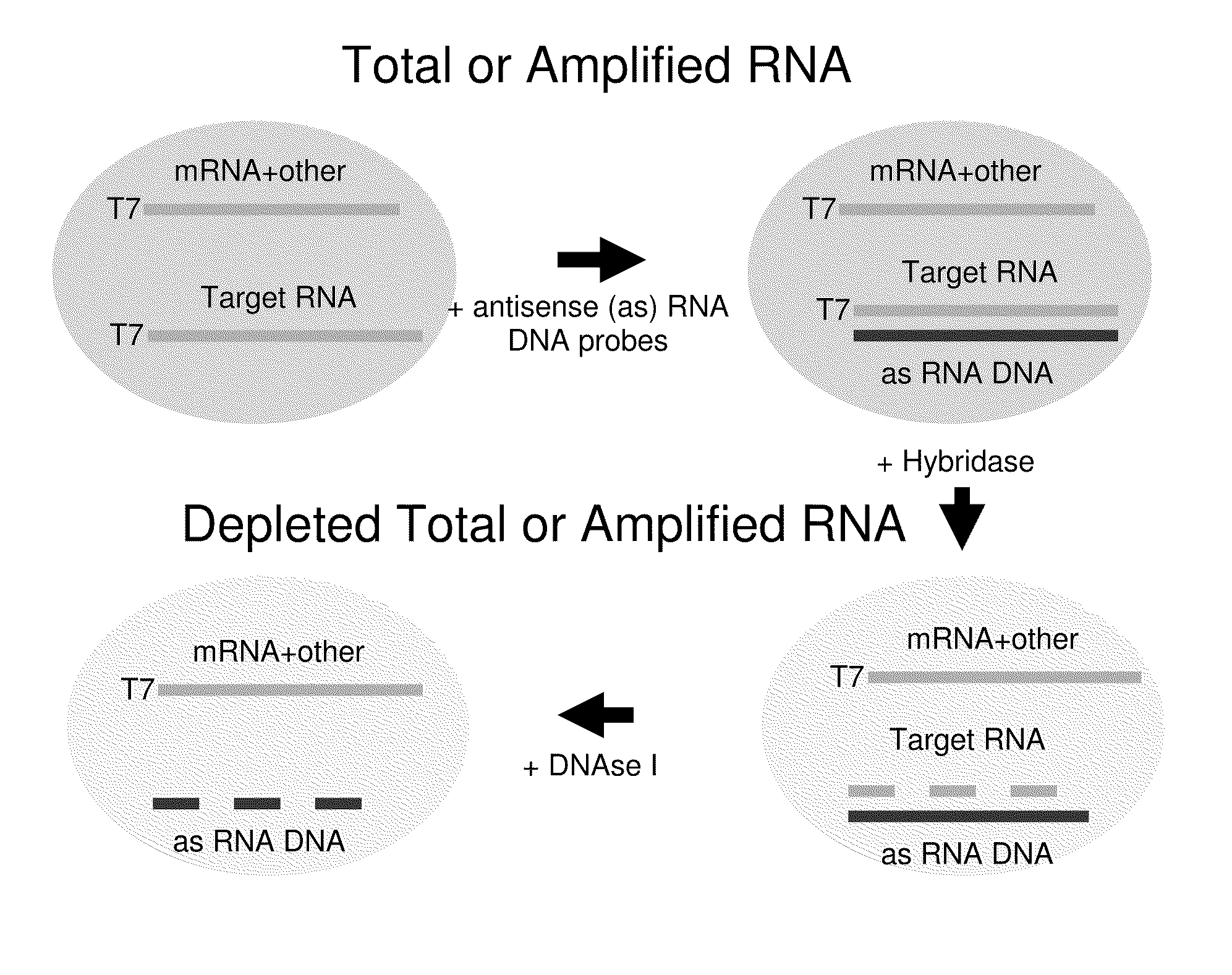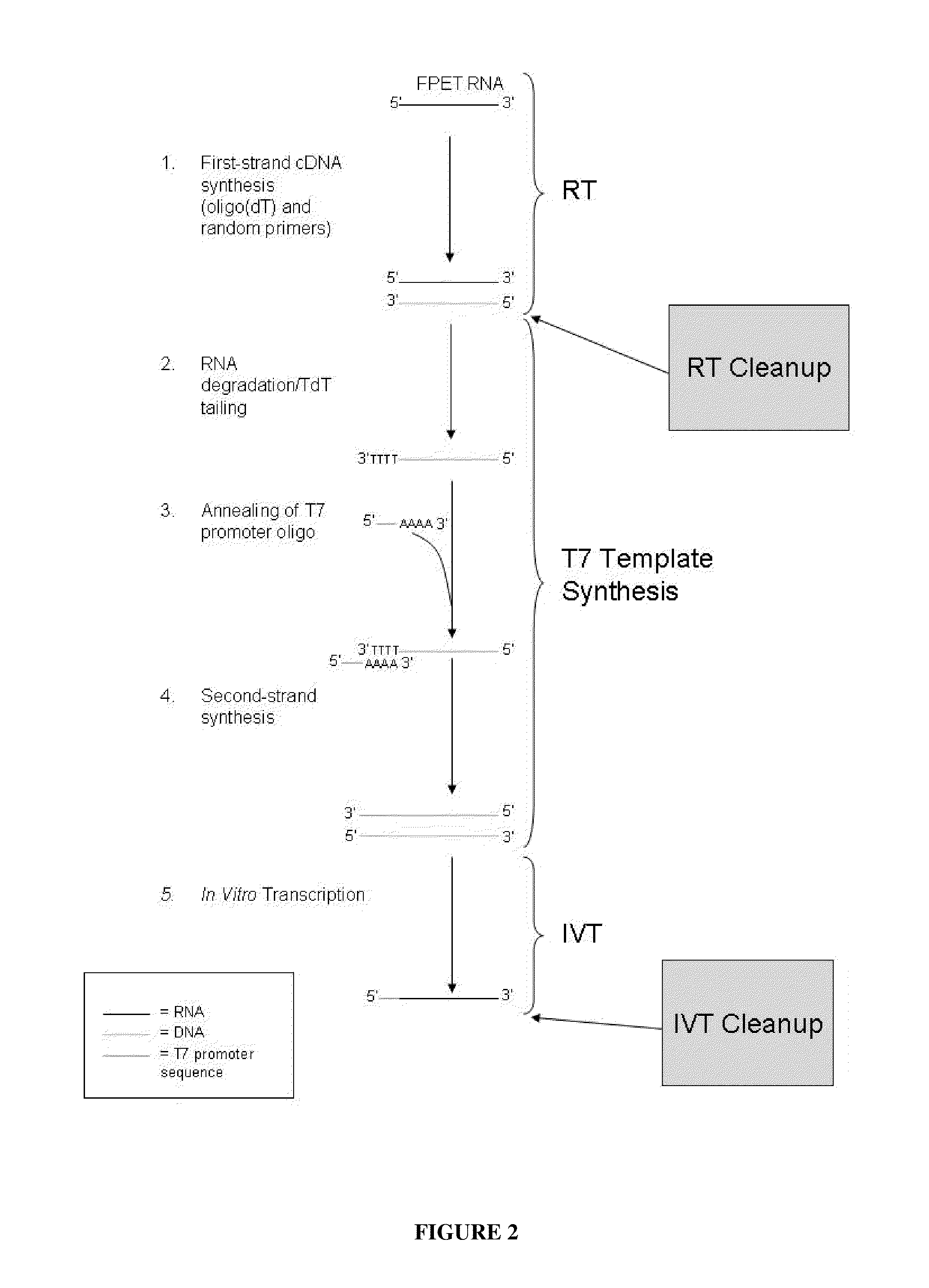Methods for depleting RNA from nucleic acid samples
a nucleic acid and rna technology, applied in the field of nucleic acid depletion methods, can solve the problems of badly degraded rna, difficult to efficiently convert rna isolated from such samples into cdna, interference with detection and/or quantification, etc., and achieve the effect of reducing interference and unnecessary work
- Summary
- Abstract
- Description
- Claims
- Application Information
AI Technical Summary
Benefits of technology
Problems solved by technology
Method used
Image
Examples
example 1
Depletion of 18S and 28S rRNA from Amplified RNA Obtained from Fixed Paraffin-Embedded Tissue (FPET) Samples of Colon Cancer Patients
[0066]Samples
[0067]A single, commercially available FPET block from a colon cancer patient (ProteoGenex, Culver City, Calif.) was used as the source of RNA for all samples in this Example. Total RNA was extracted from the tissue block using the MasterPure™ Kit (Epicentre Biotechnologies, Madison, Wis.). The total RNA was amplified as outlined in FIG. 2 and described in U.S. Pub. No. 2005 / 0196782, published Sep. 8, 2005, and U.S. Pub. No. 2009 / 0042192, published Feb. 12, 2009. Briefly, either 25 ng or 50 ng of an RNA sample was converted to cDNA via reverse transcription using oligo dT and random nonamers. The RNA was then degraded by incubation with RNase H and the cDNA was poly-dT tailed through the action of a terminal deoxynucleotidyl transferase (TdT) enzyme. A T7 RNA polymerase promoter sequence was then hybridized to the tailed cDNA, and made dou...
example 2
Preparation of cDNA Libraries from rRNA-Depleted Amplified RNA Obtained from FPET
[0102]As illustrated in FIG. 6, the amplified RNA from Example 1 was reverse-transcribed with adaptor (P1)-modified random hexamers (P1-N6 primer) (P1: 5′-AGATCGGAAGAGCGTCGTGTAGGGAAAGAGTGTAGATCTCGGTGGTCGCC GTATCATT-3′) (SEQ ID NO: 89) to produce cDNA. The cDNA was resolved on a 6% TBE-Urea gel and the region from 116-200 bp was excised and cut into four equal slices. PCR was performed on one slice using the P1 primer and an adaptor (P2)-modified T7 primer (P2-T7 primer) containing an intervening nucleotide “barcode” between the P2 and T7 sequences that serves to identify each sample (P2: 5′-CAAGCAGAAGACGGCA TACGAGAT-3′) (SEQ ID NO: 90); (T7: 5′-GGGAGACGCGTGTAAA-3′) (SEQ ID NO: 91). The PCR reaction was then purified. The procedure is outlined below.[0103]1. First-strand cDNA synthesis[0104]a. Primer hybridization. The following were mixed:[0105]500 ng amplified, rRNA-depleted RNA[0106]2 μL of a 2 uM sol...
example 3
Depletion of 18S and 28S rRNA from Amplified RNA Obtained from Fixed Paraffin-Embedded Tissue (FPET) Samples of Breast Cancer Patients
[0158]Samples
[0159]Two breast cancer FPET blocks were obtained from Providence-St. Joseph Medical Center, Burbank Calif., and were used as the source of RNA for all samples in this Example. Total RNA was extracted from the tissue block using the MasterPure™ Kit (Epicentre Biotechnologies, Madison, Wis.) and the total RNA was amplified as described in Example 1. The RNAs were classified as “Lo ER” (exhibiting low EstR1 gene expression) or “Hi ER” (exhibiting high EstR1 gene expression).
[0160]FIGS. 7 and 8 show the average difference correlation of total unamplified RNA vs amplified Lo ER RNA or amplified Hi ER RNA, respectively, over 96 genes. Genes that did not meet the detection threshold were excluded. The r2 values were 0.876 and 0.891, respectively.
[0161]Depletion of 18S and 28S rRNA from the Amplified RNA Sample
[0162]The “Lo ER” and “Hi ER” ampli...
PUM
| Property | Measurement | Unit |
|---|---|---|
| temperature | aaaaa | aaaaa |
| temperature | aaaaa | aaaaa |
| temperature | aaaaa | aaaaa |
Abstract
Description
Claims
Application Information
 Login to View More
Login to View More - R&D
- Intellectual Property
- Life Sciences
- Materials
- Tech Scout
- Unparalleled Data Quality
- Higher Quality Content
- 60% Fewer Hallucinations
Browse by: Latest US Patents, China's latest patents, Technical Efficacy Thesaurus, Application Domain, Technology Topic, Popular Technical Reports.
© 2025 PatSnap. All rights reserved.Legal|Privacy policy|Modern Slavery Act Transparency Statement|Sitemap|About US| Contact US: help@patsnap.com



